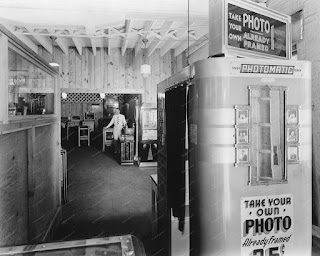Let's take a minute to thank the International Mutoscope and Reel Company! No one provided better value for your time and your dime. Photomatic photographs are but one example of their product line, but the one which is the most fun. An early robot with an eye. The company also had the horrible taste to produce "The Atomic Bomber" in 1946, unfortunately. They called it "timely" as the radiation hadn't yet dispersed.

Photomatic machines were plopped down where folks killed time. Railroad stations mostly...and the same places Starbucks wedges their six dollar a cup baristas today. The company created numerous "peep-show" type things which were among the first general circulation machines to display moving pictures. Drop a coin, peer in and see something you think you never saw before! Often "what the butler saw" type things. Mutoscope Co. could suck a coin out of a pocket or a parking meter. They created weight, fortune and and arcade machines, but as far as I know the Photomatic was the only one with a chemical bath built right in.

Time magazine profiled the owner of International Mutoscope Reel company William Rabkin in 1934 calling him a "fast-talking Jew"...don't they all? In the article they credit Rabkin with inventing THE CLAW! That's right...the machine at the carnival which allows one to move around a tiny steam shovel and pick up useless trinkets instead of the valuable watch sitting on a pedestal among the junk. Now-a-days the crane is a little steam shovel, but it still drops and closes JUST as you get close to the prize.
Should we give credit or praise to a company which referred to their customers as "marks?" Yea...it was all in good fun. No one kicked Mutoscope machines if they lost (or rather WHEN they lost) as the process was as good as the prize. Junior and Dad could hear the gear grinding out the photo at the train station! They took a little time to develop your photograph...but you were stuck there anyway. Back then, unlike today, of course, modes of transportation were always late.
Soon, the machines spread. Here, some goober has blocked the entrance of his arcade palace with one. See any customers? Maybe the next thing which went in was a back door.
The Photomatic patent, sans mechanical guts.
What I have not yet figured out is how they got the cool metal frames on the photo. As you can see from the reverse, they were not only smart, they were brilliant. One here allows the owner to peel out a built in stand for displaying the photo on your dresser. Note also the space for identifying yourself? Imagine how big a business THAT came to be. These often turn up identified as ID Badges.
Eventually the Photomatic machine produced GIANT photos! 3" x 5" for those with large egos. There was also a machine which would spit out six photos at a time.
One of parent company Mutoscope's most profitable products was cheesecake. Proto-porn dispensed for Dad.
Founder William Rabkin was often criticized by moral monitors for making risqué girly photographs available to all. In 1956 he fell (or was tossed) to his death from the window of his 6th floor apartment on Central Park West. Was someone or somebody trying to muscle into his coin-op business? Unlikely. From Jukeboxes to pinball machines, a small tribute to wise guys was often skimmed off a sack of dimes in those days, but Rabkin had gone out of business in 1949. It wasn't until seven years later he dropped. Even the name "Mutoscope" is no longer a trademark, apparently. Need a nice name for your website? It is available. Still, when the owner of a cash heavy dicey business falls from a window, it is not out of line to wonder if someone owed someone money. After finding his body, his son said the old man "suffered dizzy spells" but I'd still think about re-opening the case.
 The most famous person photographed by the photomat was Franklin Swantek. He took 455 of them, all self-portraits! Well, they are all self-portraits, but "self" is a camera here. See his story HERE.
The most famous person photographed by the photomat was Franklin Swantek. He took 455 of them, all self-portraits! Well, they are all self-portraits, but "self" is a camera here. See his story HERE.
In my mind, the best part of a pile of photomatic photographs is that they make noise when shuffled. The cheap metal frames have a nice solid clunk as one flips through them. The company also made cheap cardboard frames for their photos, but the metal is more fun. There appears to be a hierarchy of value for them today. Especially bright color frames and especially goofy faces are among the desirable formats, but so are the few which are well-focused and haunting.
Photomatic photographs collection Jim Linderman Dull Tool Dim Bulb




















































